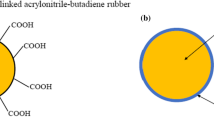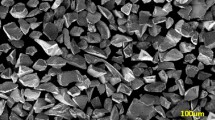Abstract
The fatigue crack propagation (FCP) of neat and modified, anhydridecured epoxy resin (EP) was studied in tensile-tensile mode at ambient temperature. As modifiers, liquid carboxyl-terminated acrylonitrile-butadiene (CTBN) and silicon rubber (SI) dispersions were used. The latter modifier in a defined particle size distribution was produced by a special latex technology, whereas the former developed in situ in the EP by phase separation during curing. The dispersion-type morphologies of the EPs were characterized by using polished sections and viewing them in a scanning electron microscope (SEM). The resulting frequency distribution curves were compared with those analyzed from fatigue fracture surfaces. Probable failure mechanisms were also studied by SEM-fractography.
Both modifiers improved the resistance to FCP by shifting the curves to higher stress intensity factor ranges (ΔK) in relation to the reference curve determined for the neat EP-matrix. The failure mechanisms, summarized also schematically, differed basically for the various modifiers. According to this, rubber-induced cavitation and shear yielding of the matrix seemed to be dominant for CTBN, which did not affect the principal crack plane. In contrast to this, crack bifurcation, branching and, hence, a forced deviation in the fatigue crack path induced by debonded SI-particles in the EP-matrix were concluded for the SI modifier. The common use of both modifiers yielded a positive synergistic effect due to the superposition of the above failure mechanisms.
Similar content being viewed by others
References
Kinloch AJ, Shaw SJ, Tod DA, Hunston DL (1983) Polymer 24:1341
Pearson RA, Yee AF (1986) J Mater Sci 21:2475
Hwang J-F, Manson JA, Hertzberg RW, Miller GA, Sperling LH (1989) Polym Eng Sci 29:1466
Yee AF, Pearson RA (1989) Fractography and failure mechanisms of rubber modified epoxide resins in “Fractography and Failure Mechanisms of Polymers and Composites” (Ed.: Roulin-Moloney AC), Elsevier Appl Sci, London, p 291
Bascom WD, Hunston DL (1989) Fracture of elastomermodified epoxy polymers. A review. In “Rubber-Toughened Plastics; Adv Chem Ser 222” (Ed.: Riew CK), Am Chem Soc, Washington, p 135
Garg AC, Mai Y-W (1988) Compos Sci Technol 31:179
Sue H-J (1991) Polym Eng Sci 31:275
Cantwell WJ, Roulin-Moloney AC (1989) Fractography and failure mechanisms of unfilled and particulate filled epoxy resins in “Fractography and Failure Mechanisms of Polymers and Composites” (Ed.: Roulin-Moloney AC), Elsevier Appl Sci, London, p 233
Moloney AC, Kausch HH, Kaiser T, Beer HR (1987) J Mater Sci 22:381
Low I-M, Mai Y-W (1989) J Mater Sci 24:1634
Hunston DL, Moulton RJ, Johnston NJ, Bascom WD (1987) Matrix resin effects in composite delamination: mode I fracture aspects in “Toughened Composites” (ASTM STP 937; Ed: Johnston NJ), Am Soc Test Mater, Philadelphia, p 74
Davis P, Moulin C, Kausch HH, Fischer M (1990) Compos Sci Technol 39:193
Chen SF, Jang BZ (1991) Compos Sci Technol 41:77
Siebert AR (1984) Morphology and dynamic mechanical behavior of rubber-toughened epoxy resins in “Rubber-Modified Thermoser Resins; Adv Chem Ser 208” (Eds.: Riew CK and Gillham JK), Am Chem Soc, Washington, 1984, p 179
Siebert AR, Guiley CD, Eplin AM (1989) Mechanical and fracture properties-Elastomer-modified epoxy model adhesives cured with an accelerated dicyandiamide system in “Rubber-Toughened Plastics; Adv Chem Ser 222” (Ed: Riew CK), Am Chem Soc, Washington, p 389
Hsich HS-Y (1990) Polym Eng Sci 30:493
Kim DH, Kim SC (1991) Polym Eng Sci 31:289
Takahashi T, Nakajima N, Saito N (1989) Morphology and mechanical properties of rubber-modified epoxy systems. Amino-terminated polysiloxane in “Rubber-toughened Plastics, Adv Chem Ser 222” (Ed: Riew CK), Am Chem Soc, Washington, p 243
Jap Pat 90. 150460 (to Sumitomo Bakelite), CA 113:193175 (1990)
Ger Pat 3 922 079 (to Hanse Chemie), CA 113:232786 (1990)
Block H, Pyrlik M (1988) Kunststoffe 78:1192
Kinloch AJ (1989) Relationship between the microstructure and fracture behavior of rubber-toughened thermosetting polymers in “Rubber-toughened Plastics, Adv Chem Ser 222” (Ed: Riew CK), Am Chem Soc, Washington, p 67
Montarnal S, Pascault J-P, Sautereau H (1989) Controlling factors in the rubber toughening of unfilled epoxy networks in “Rubber-toughened Plastics, Adv Chem Ser 222” (Ed: Riew CK), Am Chem Soc, Washington, p 193
Pearson RA, Yee AF (1989) J Mater Sci 24:2571
Manson JA, Hertzberg RW, Connelly GM, Hwang J-F (1986) in “Multicomponent Polymer Materials; ACS Adv Chem Ser 211” (Eds: Paul DR, Sperling LH), Am Chem Soc, Washington, p 291
Hwang J-F, Manson JA, Herztberg RW, Miller GA, Sperling LH (1989) Polym Eng Sci 29:1477
Altstädt V, Lang RW, Neu A (1991) The influence of resin, fiber and interface on delamination fatigue crack growth of composites in “Durability of Polymer Based Composite Systems for Structural Applications” (Eds: Cardon AH, Verchery G), Elsevier Appl Sci, London, p 180
Paris PC, Erdogan F (1963) J Bas Eng Trans ASME Ser D 85:528
Kausch HH (1987) Polymer Fracture, Springer, Berlin
Einfluß des matrixtyps auf die statischen und dynamischen Eigenschaften von polymeren Hochleistungsverbundwerkstoffen, BMFT Research Report (03M 1010), 1990
Purslow D (1986) Composites 17:289
Robertson RE, Mindroiu VE (1987) Polym Eng Sci 27:55
Lange FF (1970) Phil Mag 22:983
Kinloch AJ, Young RJ (1983) Fracture Behaviour of Polymers. Appl Sci Publ, London
Newaz GM (1987) Microstructural aspects of crack propagation in filled polymers in “Fractography of Modern Engineering Materials: Composites and Metals (ASTM STP 948, Eds: Masters JE, Au JJ), Am Soc Test Mater, Philadelphia, p 177
Pearson RA, Yee AF (1991) J Mater Sci 26:3828
Evans AG, Ahmad ZB, Gilbert DG, Beaumont PWR (1986) Acta Metall 34:79
Kunz-Douglass S, Beaumont PWR, Ashby MF (1980) J Mater Sci 15:1109
Cantwell WJ, Smith JW, Kausch HH, Kaiser T (1990) j Mater Sci 25:633
Author information
Authors and Affiliations
Additional information
Dedicated to the 60th birthday of Prof. H. H. Kausch
Rights and permissions
About this article
Cite this article
Karger-Kocsis, J., Friedrich, K. Fatigue crack propagation and related failure in modified, andhydride-cured epoxy resins. Colloid Polym Sci 270, 549–562 (1992). https://doi.org/10.1007/BF00658286
Received:
Accepted:
Issue Date:
DOI: https://doi.org/10.1007/BF00658286




